Financial Accounting 1 Report: Users, Framework, and Analysis
VerifiedAdded on 2019/12/04
|18
|5378
|74
Report
AI Summary
This report on financial accounting provides a comprehensive overview of the subject, focusing on the needs of various users of financial statements, the influence of legal and regulatory frameworks, and the application of accounting principles. The report analyzes the requirements of stakeholders such as managers, employees, owners, investors, financial institutions, suppliers, and the government, highlighting their specific information needs. It explores the impact of the Companies Act 2006 and International Accounting Standards on financial reporting, emphasizing the importance of accurate and audited financial statements. The report also assesses the implications of legal and regulatory frameworks on users, demonstrating how adherence to these standards enhances the transparency and reliability of financial information. Furthermore, the report delves into the preparation of financial statements, including adjustments, incomplete records, and consolidated balance sheets, while also covering financial ratio analysis to assess the performance and position of a company. The report uses EL Ltd as a case study to illustrate the practical application of these concepts, providing a clear understanding of how financial accounting principles are applied in a real-world business context. The report concludes with a discussion on how different types of business organizations apply these principles.
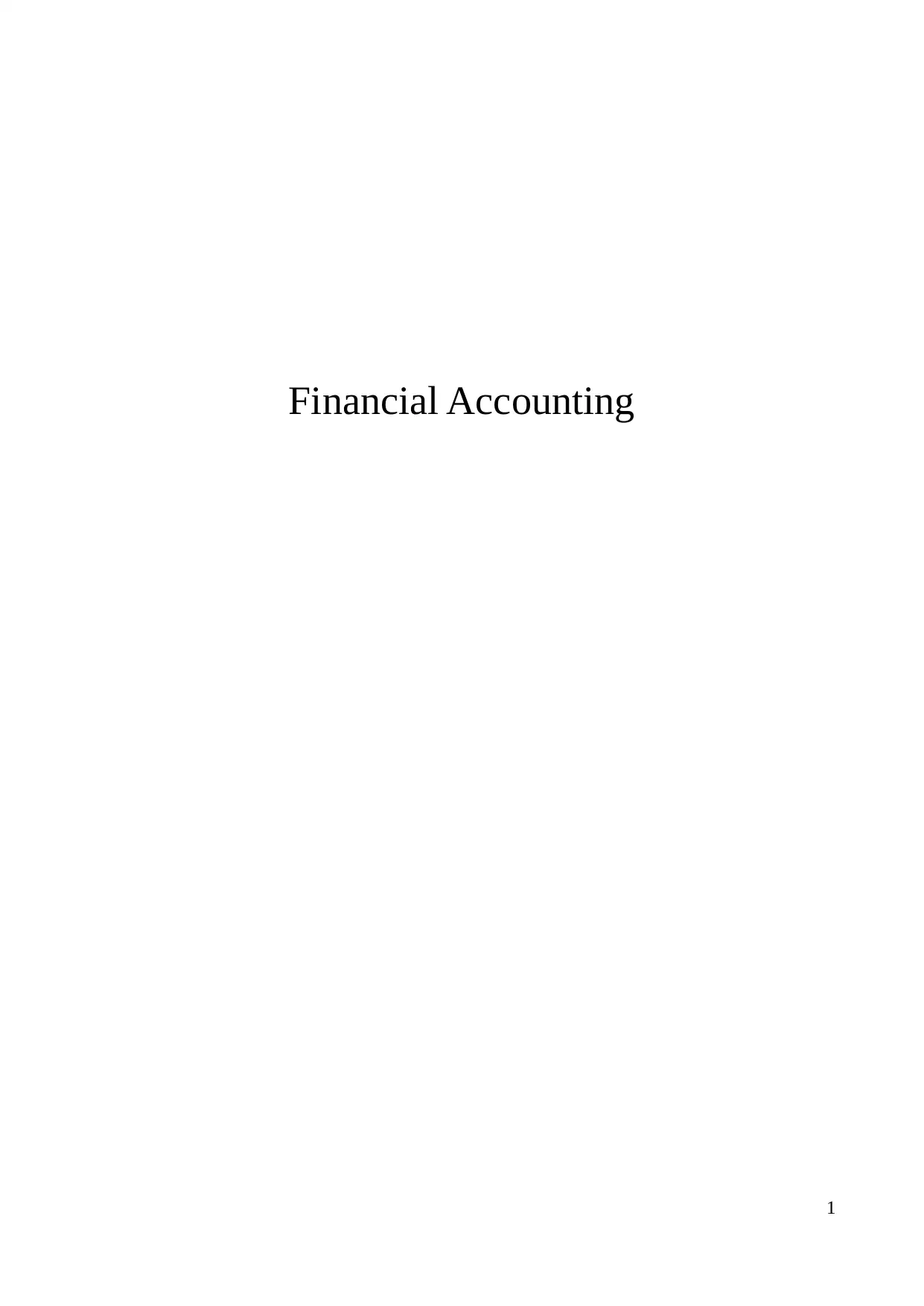
Financial Accounting
1
1
Paraphrase This Document
Need a fresh take? Get an instant paraphrase of this document with our AI Paraphraser
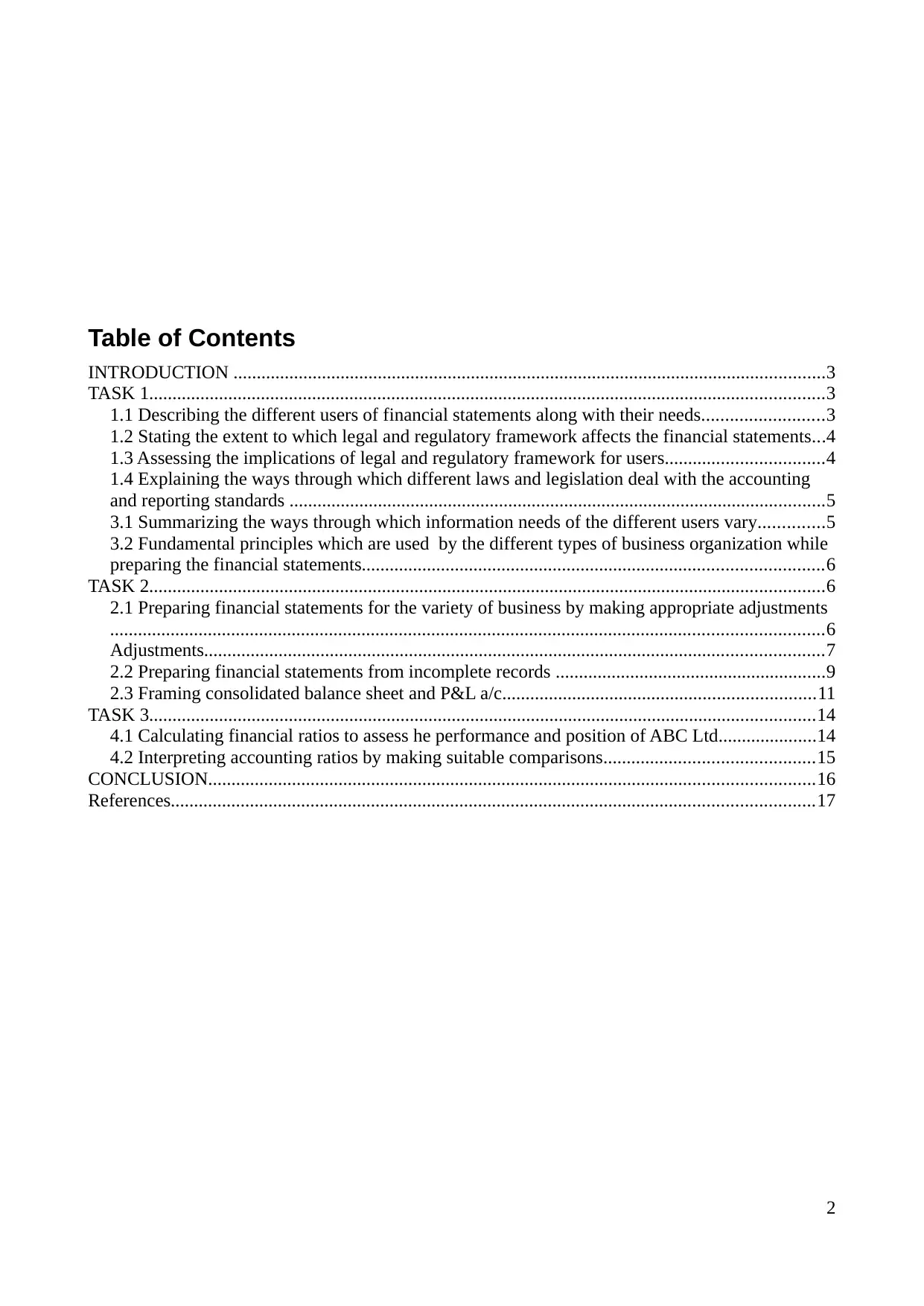
Table of Contents
INTRODUCTION ...............................................................................................................................3
TASK 1.................................................................................................................................................3
1.1 Describing the different users of financial statements along with their needs..........................3
1.2 Stating the extent to which legal and regulatory framework affects the financial statements...4
1.3 Assessing the implications of legal and regulatory framework for users..................................4
1.4 Explaining the ways through which different laws and legislation deal with the accounting
and reporting standards ...................................................................................................................5
3.1 Summarizing the ways through which information needs of the different users vary..............5
3.2 Fundamental principles which are used by the different types of business organization while
preparing the financial statements...................................................................................................6
TASK 2.................................................................................................................................................6
2.1 Preparing financial statements for the variety of business by making appropriate adjustments
.........................................................................................................................................................6
Adjustments.....................................................................................................................................7
2.2 Preparing financial statements from incomplete records ..........................................................9
2.3 Framing consolidated balance sheet and P&L a/c...................................................................11
TASK 3...............................................................................................................................................14
4.1 Calculating financial ratios to assess he performance and position of ABC Ltd.....................14
4.2 Interpreting accounting ratios by making suitable comparisons.............................................15
CONCLUSION..................................................................................................................................16
References..........................................................................................................................................17
2
INTRODUCTION ...............................................................................................................................3
TASK 1.................................................................................................................................................3
1.1 Describing the different users of financial statements along with their needs..........................3
1.2 Stating the extent to which legal and regulatory framework affects the financial statements...4
1.3 Assessing the implications of legal and regulatory framework for users..................................4
1.4 Explaining the ways through which different laws and legislation deal with the accounting
and reporting standards ...................................................................................................................5
3.1 Summarizing the ways through which information needs of the different users vary..............5
3.2 Fundamental principles which are used by the different types of business organization while
preparing the financial statements...................................................................................................6
TASK 2.................................................................................................................................................6
2.1 Preparing financial statements for the variety of business by making appropriate adjustments
.........................................................................................................................................................6
Adjustments.....................................................................................................................................7
2.2 Preparing financial statements from incomplete records ..........................................................9
2.3 Framing consolidated balance sheet and P&L a/c...................................................................11
TASK 3...............................................................................................................................................14
4.1 Calculating financial ratios to assess he performance and position of ABC Ltd.....................14
4.2 Interpreting accounting ratios by making suitable comparisons.............................................15
CONCLUSION..................................................................................................................................16
References..........................................................................................................................................17
2
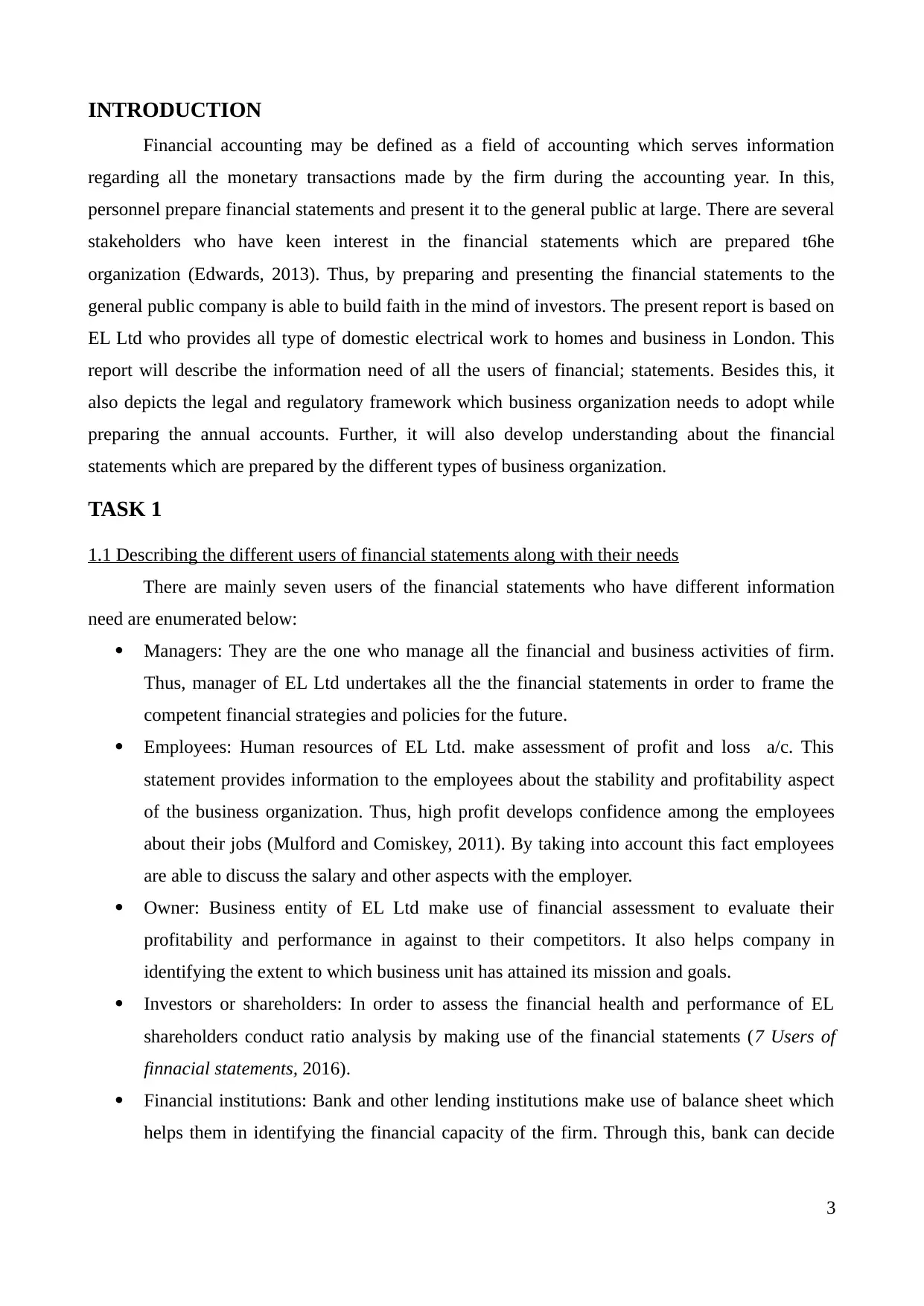
INTRODUCTION
Financial accounting may be defined as a field of accounting which serves information
regarding all the monetary transactions made by the firm during the accounting year. In this,
personnel prepare financial statements and present it to the general public at large. There are several
stakeholders who have keen interest in the financial statements which are prepared t6he
organization (Edwards, 2013). Thus, by preparing and presenting the financial statements to the
general public company is able to build faith in the mind of investors. The present report is based on
EL Ltd who provides all type of domestic electrical work to homes and business in London. This
report will describe the information need of all the users of financial; statements. Besides this, it
also depicts the legal and regulatory framework which business organization needs to adopt while
preparing the annual accounts. Further, it will also develop understanding about the financial
statements which are prepared by the different types of business organization.
TASK 1
1.1 Describing the different users of financial statements along with their needs
There are mainly seven users of the financial statements who have different information
need are enumerated below:
Managers: They are the one who manage all the financial and business activities of firm.
Thus, manager of EL Ltd undertakes all the the financial statements in order to frame the
competent financial strategies and policies for the future.
Employees: Human resources of EL Ltd. make assessment of profit and loss a/c. This
statement provides information to the employees about the stability and profitability aspect
of the business organization. Thus, high profit develops confidence among the employees
about their jobs (Mulford and Comiskey, 2011). By taking into account this fact employees
are able to discuss the salary and other aspects with the employer.
Owner: Business entity of EL Ltd make use of financial assessment to evaluate their
profitability and performance in against to their competitors. It also helps company in
identifying the extent to which business unit has attained its mission and goals.
Investors or shareholders: In order to assess the financial health and performance of EL
shareholders conduct ratio analysis by making use of the financial statements (7 Users of
finnacial statements, 2016).
Financial institutions: Bank and other lending institutions make use of balance sheet which
helps them in identifying the financial capacity of the firm. Through this, bank can decide
3
Financial accounting may be defined as a field of accounting which serves information
regarding all the monetary transactions made by the firm during the accounting year. In this,
personnel prepare financial statements and present it to the general public at large. There are several
stakeholders who have keen interest in the financial statements which are prepared t6he
organization (Edwards, 2013). Thus, by preparing and presenting the financial statements to the
general public company is able to build faith in the mind of investors. The present report is based on
EL Ltd who provides all type of domestic electrical work to homes and business in London. This
report will describe the information need of all the users of financial; statements. Besides this, it
also depicts the legal and regulatory framework which business organization needs to adopt while
preparing the annual accounts. Further, it will also develop understanding about the financial
statements which are prepared by the different types of business organization.
TASK 1
1.1 Describing the different users of financial statements along with their needs
There are mainly seven users of the financial statements who have different information
need are enumerated below:
Managers: They are the one who manage all the financial and business activities of firm.
Thus, manager of EL Ltd undertakes all the the financial statements in order to frame the
competent financial strategies and policies for the future.
Employees: Human resources of EL Ltd. make assessment of profit and loss a/c. This
statement provides information to the employees about the stability and profitability aspect
of the business organization. Thus, high profit develops confidence among the employees
about their jobs (Mulford and Comiskey, 2011). By taking into account this fact employees
are able to discuss the salary and other aspects with the employer.
Owner: Business entity of EL Ltd make use of financial assessment to evaluate their
profitability and performance in against to their competitors. It also helps company in
identifying the extent to which business unit has attained its mission and goals.
Investors or shareholders: In order to assess the financial health and performance of EL
shareholders conduct ratio analysis by making use of the financial statements (7 Users of
finnacial statements, 2016).
Financial institutions: Bank and other lending institutions make use of balance sheet which
helps them in identifying the financial capacity of the firm. Through this, bank can decide
3
⊘ This is a preview!⊘
Do you want full access?
Subscribe today to unlock all pages.

Trusted by 1+ million students worldwide
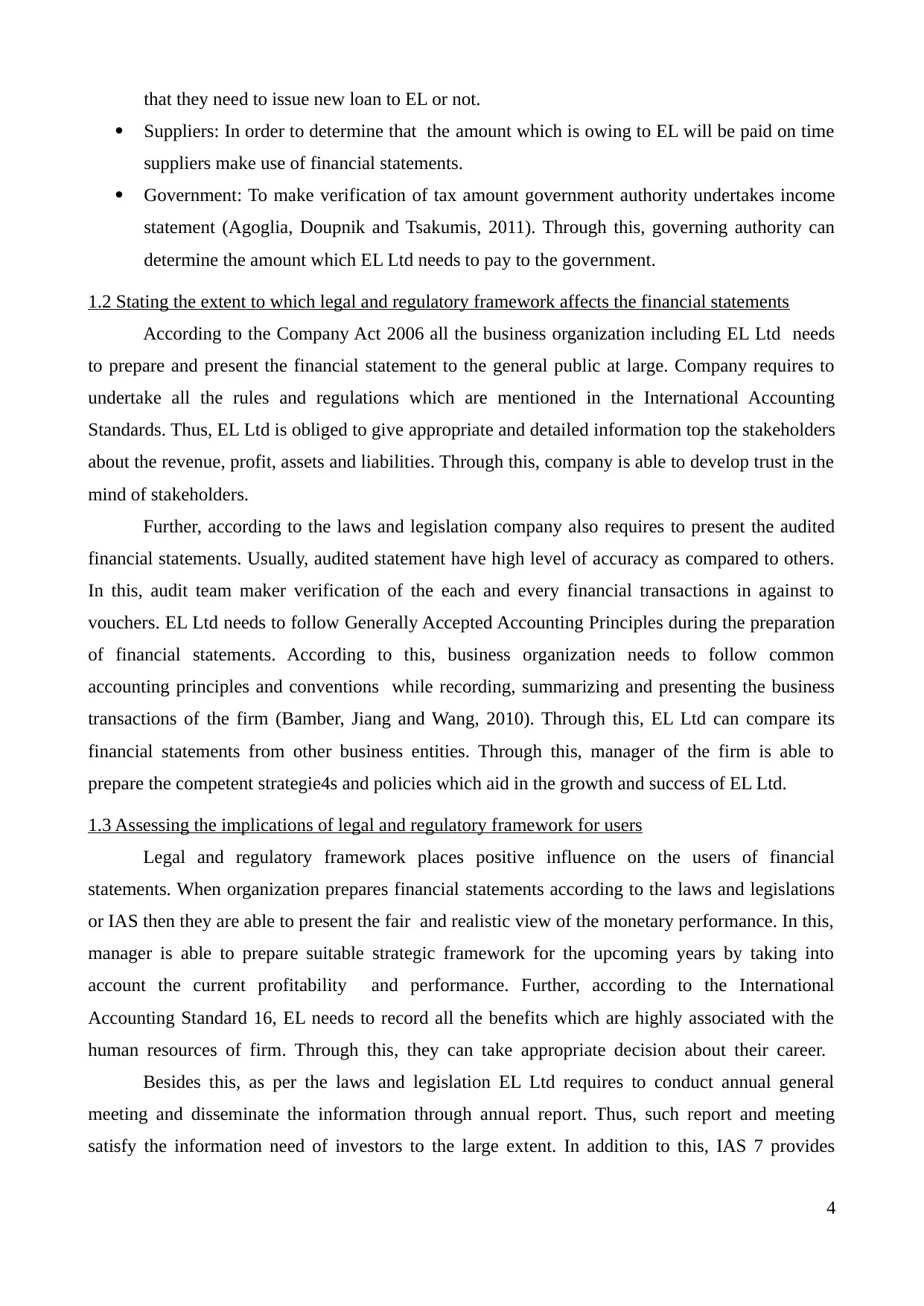
that they need to issue new loan to EL or not.
Suppliers: In order to determine that the amount which is owing to EL will be paid on time
suppliers make use of financial statements.
Government: To make verification of tax amount government authority undertakes income
statement (Agoglia, Doupnik and Tsakumis, 2011). Through this, governing authority can
determine the amount which EL Ltd needs to pay to the government.
1.2 Stating the extent to which legal and regulatory framework affects the financial statements
According to the Company Act 2006 all the business organization including EL Ltd needs
to prepare and present the financial statement to the general public at large. Company requires to
undertake all the rules and regulations which are mentioned in the International Accounting
Standards. Thus, EL Ltd is obliged to give appropriate and detailed information top the stakeholders
about the revenue, profit, assets and liabilities. Through this, company is able to develop trust in the
mind of stakeholders.
Further, according to the laws and legislation company also requires to present the audited
financial statements. Usually, audited statement have high level of accuracy as compared to others.
In this, audit team maker verification of the each and every financial transactions in against to
vouchers. EL Ltd needs to follow Generally Accepted Accounting Principles during the preparation
of financial statements. According to this, business organization needs to follow common
accounting principles and conventions while recording, summarizing and presenting the business
transactions of the firm (Bamber, Jiang and Wang, 2010). Through this, EL Ltd can compare its
financial statements from other business entities. Through this, manager of the firm is able to
prepare the competent strategie4s and policies which aid in the growth and success of EL Ltd.
1.3 Assessing the implications of legal and regulatory framework for users
Legal and regulatory framework places positive influence on the users of financial
statements. When organization prepares financial statements according to the laws and legislations
or IAS then they are able to present the fair and realistic view of the monetary performance. In this,
manager is able to prepare suitable strategic framework for the upcoming years by taking into
account the current profitability and performance. Further, according to the International
Accounting Standard 16, EL needs to record all the benefits which are highly associated with the
human resources of firm. Through this, they can take appropriate decision about their career.
Besides this, as per the laws and legislation EL Ltd requires to conduct annual general
meeting and disseminate the information through annual report. Thus, such report and meeting
satisfy the information need of investors to the large extent. In addition to this, IAS 7 provides
4
Suppliers: In order to determine that the amount which is owing to EL will be paid on time
suppliers make use of financial statements.
Government: To make verification of tax amount government authority undertakes income
statement (Agoglia, Doupnik and Tsakumis, 2011). Through this, governing authority can
determine the amount which EL Ltd needs to pay to the government.
1.2 Stating the extent to which legal and regulatory framework affects the financial statements
According to the Company Act 2006 all the business organization including EL Ltd needs
to prepare and present the financial statement to the general public at large. Company requires to
undertake all the rules and regulations which are mentioned in the International Accounting
Standards. Thus, EL Ltd is obliged to give appropriate and detailed information top the stakeholders
about the revenue, profit, assets and liabilities. Through this, company is able to develop trust in the
mind of stakeholders.
Further, according to the laws and legislation company also requires to present the audited
financial statements. Usually, audited statement have high level of accuracy as compared to others.
In this, audit team maker verification of the each and every financial transactions in against to
vouchers. EL Ltd needs to follow Generally Accepted Accounting Principles during the preparation
of financial statements. According to this, business organization needs to follow common
accounting principles and conventions while recording, summarizing and presenting the business
transactions of the firm (Bamber, Jiang and Wang, 2010). Through this, EL Ltd can compare its
financial statements from other business entities. Through this, manager of the firm is able to
prepare the competent strategie4s and policies which aid in the growth and success of EL Ltd.
1.3 Assessing the implications of legal and regulatory framework for users
Legal and regulatory framework places positive influence on the users of financial
statements. When organization prepares financial statements according to the laws and legislations
or IAS then they are able to present the fair and realistic view of the monetary performance. In this,
manager is able to prepare suitable strategic framework for the upcoming years by taking into
account the current profitability and performance. Further, according to the International
Accounting Standard 16, EL needs to record all the benefits which are highly associated with the
human resources of firm. Through this, they can take appropriate decision about their career.
Besides this, as per the laws and legislation EL Ltd requires to conduct annual general
meeting and disseminate the information through annual report. Thus, such report and meeting
satisfy the information need of investors to the large extent. In addition to this, IAS 7 provides
4
Paraphrase This Document
Need a fresh take? Get an instant paraphrase of this document with our AI Paraphraser
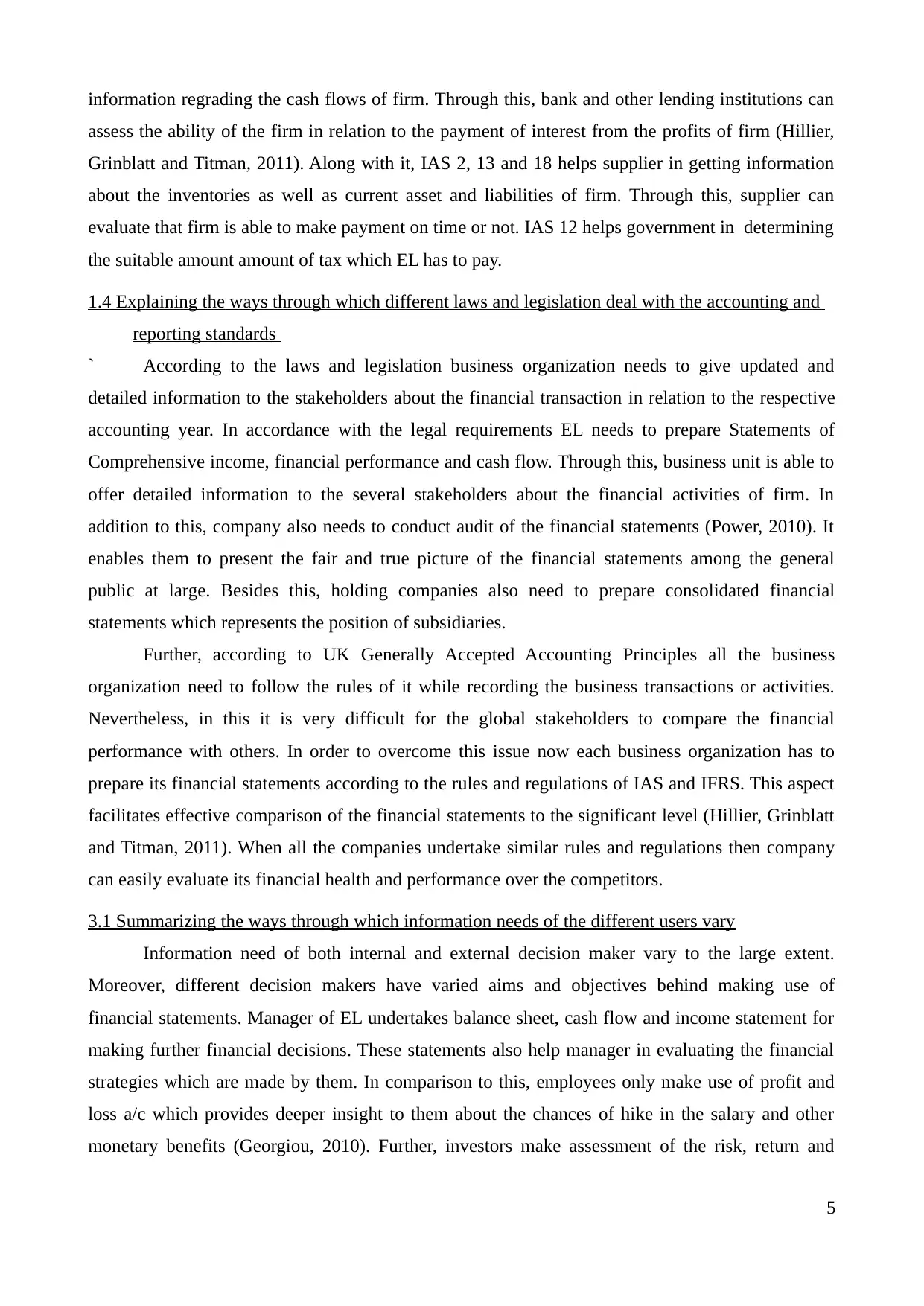
information regrading the cash flows of firm. Through this, bank and other lending institutions can
assess the ability of the firm in relation to the payment of interest from the profits of firm (Hillier,
Grinblatt and Titman, 2011). Along with it, IAS 2, 13 and 18 helps supplier in getting information
about the inventories as well as current asset and liabilities of firm. Through this, supplier can
evaluate that firm is able to make payment on time or not. IAS 12 helps government in determining
the suitable amount amount of tax which EL has to pay.
1.4 Explaining the ways through which different laws and legislation deal with the accounting and
reporting standards
` According to the laws and legislation business organization needs to give updated and
detailed information to the stakeholders about the financial transaction in relation to the respective
accounting year. In accordance with the legal requirements EL needs to prepare Statements of
Comprehensive income, financial performance and cash flow. Through this, business unit is able to
offer detailed information to the several stakeholders about the financial activities of firm. In
addition to this, company also needs to conduct audit of the financial statements (Power, 2010). It
enables them to present the fair and true picture of the financial statements among the general
public at large. Besides this, holding companies also need to prepare consolidated financial
statements which represents the position of subsidiaries.
Further, according to UK Generally Accepted Accounting Principles all the business
organization need to follow the rules of it while recording the business transactions or activities.
Nevertheless, in this it is very difficult for the global stakeholders to compare the financial
performance with others. In order to overcome this issue now each business organization has to
prepare its financial statements according to the rules and regulations of IAS and IFRS. This aspect
facilitates effective comparison of the financial statements to the significant level (Hillier, Grinblatt
and Titman, 2011). When all the companies undertake similar rules and regulations then company
can easily evaluate its financial health and performance over the competitors.
3.1 Summarizing the ways through which information needs of the different users vary
Information need of both internal and external decision maker vary to the large extent.
Moreover, different decision makers have varied aims and objectives behind making use of
financial statements. Manager of EL undertakes balance sheet, cash flow and income statement for
making further financial decisions. These statements also help manager in evaluating the financial
strategies which are made by them. In comparison to this, employees only make use of profit and
loss a/c which provides deeper insight to them about the chances of hike in the salary and other
monetary benefits (Georgiou, 2010). Further, investors make assessment of the risk, return and
5
assess the ability of the firm in relation to the payment of interest from the profits of firm (Hillier,
Grinblatt and Titman, 2011). Along with it, IAS 2, 13 and 18 helps supplier in getting information
about the inventories as well as current asset and liabilities of firm. Through this, supplier can
evaluate that firm is able to make payment on time or not. IAS 12 helps government in determining
the suitable amount amount of tax which EL has to pay.
1.4 Explaining the ways through which different laws and legislation deal with the accounting and
reporting standards
` According to the laws and legislation business organization needs to give updated and
detailed information to the stakeholders about the financial transaction in relation to the respective
accounting year. In accordance with the legal requirements EL needs to prepare Statements of
Comprehensive income, financial performance and cash flow. Through this, business unit is able to
offer detailed information to the several stakeholders about the financial activities of firm. In
addition to this, company also needs to conduct audit of the financial statements (Power, 2010). It
enables them to present the fair and true picture of the financial statements among the general
public at large. Besides this, holding companies also need to prepare consolidated financial
statements which represents the position of subsidiaries.
Further, according to UK Generally Accepted Accounting Principles all the business
organization need to follow the rules of it while recording the business transactions or activities.
Nevertheless, in this it is very difficult for the global stakeholders to compare the financial
performance with others. In order to overcome this issue now each business organization has to
prepare its financial statements according to the rules and regulations of IAS and IFRS. This aspect
facilitates effective comparison of the financial statements to the significant level (Hillier, Grinblatt
and Titman, 2011). When all the companies undertake similar rules and regulations then company
can easily evaluate its financial health and performance over the competitors.
3.1 Summarizing the ways through which information needs of the different users vary
Information need of both internal and external decision maker vary to the large extent.
Moreover, different decision makers have varied aims and objectives behind making use of
financial statements. Manager of EL undertakes balance sheet, cash flow and income statement for
making further financial decisions. These statements also help manager in evaluating the financial
strategies which are made by them. In comparison to this, employees only make use of profit and
loss a/c which provides deeper insight to them about the chances of hike in the salary and other
monetary benefits (Georgiou, 2010). Further, investors make assessment of the risk, return and
5
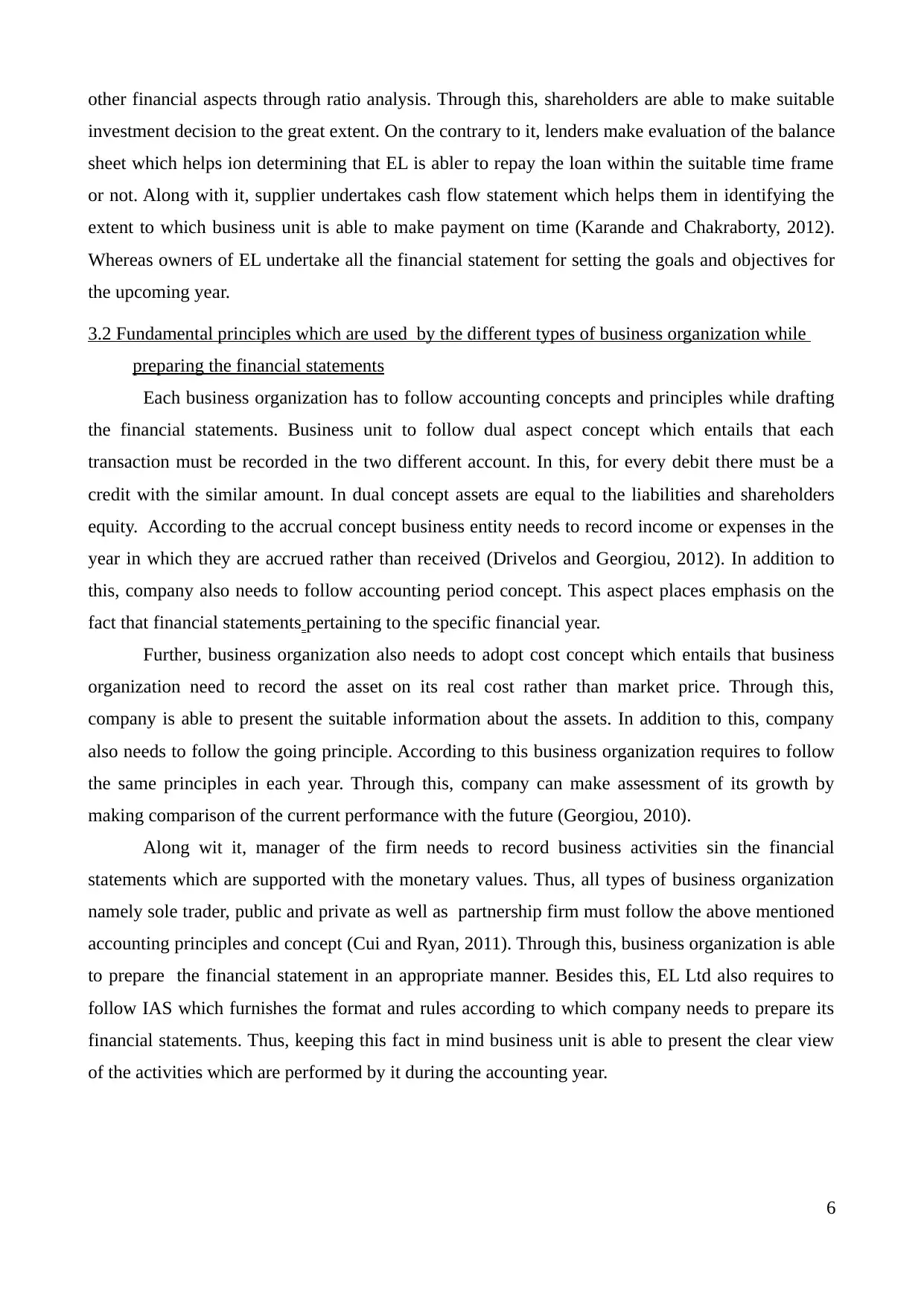
other financial aspects through ratio analysis. Through this, shareholders are able to make suitable
investment decision to the great extent. On the contrary to it, lenders make evaluation of the balance
sheet which helps ion determining that EL is abler to repay the loan within the suitable time frame
or not. Along with it, supplier undertakes cash flow statement which helps them in identifying the
extent to which business unit is able to make payment on time (Karande and Chakraborty, 2012).
Whereas owners of EL undertake all the financial statement for setting the goals and objectives for
the upcoming year.
3.2 Fundamental principles which are used by the different types of business organization while
preparing the financial statements
Each business organization has to follow accounting concepts and principles while drafting
the financial statements. Business unit to follow dual aspect concept which entails that each
transaction must be recorded in the two different account. In this, for every debit there must be a
credit with the similar amount. In dual concept assets are equal to the liabilities and shareholders
equity. According to the accrual concept business entity needs to record income or expenses in the
year in which they are accrued rather than received (Drivelos and Georgiou, 2012). In addition to
this, company also needs to follow accounting period concept. This aspect places emphasis on the
fact that financial statements pertaining to the specific financial year.
Further, business organization also needs to adopt cost concept which entails that business
organization need to record the asset on its real cost rather than market price. Through this,
company is able to present the suitable information about the assets. In addition to this, company
also needs to follow the going principle. According to this business organization requires to follow
the same principles in each year. Through this, company can make assessment of its growth by
making comparison of the current performance with the future (Georgiou, 2010).
Along wit it, manager of the firm needs to record business activities sin the financial
statements which are supported with the monetary values. Thus, all types of business organization
namely sole trader, public and private as well as partnership firm must follow the above mentioned
accounting principles and concept (Cui and Ryan, 2011). Through this, business organization is able
to prepare the financial statement in an appropriate manner. Besides this, EL Ltd also requires to
follow IAS which furnishes the format and rules according to which company needs to prepare its
financial statements. Thus, keeping this fact in mind business unit is able to present the clear view
of the activities which are performed by it during the accounting year.
6
investment decision to the great extent. On the contrary to it, lenders make evaluation of the balance
sheet which helps ion determining that EL is abler to repay the loan within the suitable time frame
or not. Along with it, supplier undertakes cash flow statement which helps them in identifying the
extent to which business unit is able to make payment on time (Karande and Chakraborty, 2012).
Whereas owners of EL undertake all the financial statement for setting the goals and objectives for
the upcoming year.
3.2 Fundamental principles which are used by the different types of business organization while
preparing the financial statements
Each business organization has to follow accounting concepts and principles while drafting
the financial statements. Business unit to follow dual aspect concept which entails that each
transaction must be recorded in the two different account. In this, for every debit there must be a
credit with the similar amount. In dual concept assets are equal to the liabilities and shareholders
equity. According to the accrual concept business entity needs to record income or expenses in the
year in which they are accrued rather than received (Drivelos and Georgiou, 2012). In addition to
this, company also needs to follow accounting period concept. This aspect places emphasis on the
fact that financial statements pertaining to the specific financial year.
Further, business organization also needs to adopt cost concept which entails that business
organization need to record the asset on its real cost rather than market price. Through this,
company is able to present the suitable information about the assets. In addition to this, company
also needs to follow the going principle. According to this business organization requires to follow
the same principles in each year. Through this, company can make assessment of its growth by
making comparison of the current performance with the future (Georgiou, 2010).
Along wit it, manager of the firm needs to record business activities sin the financial
statements which are supported with the monetary values. Thus, all types of business organization
namely sole trader, public and private as well as partnership firm must follow the above mentioned
accounting principles and concept (Cui and Ryan, 2011). Through this, business organization is able
to prepare the financial statement in an appropriate manner. Besides this, EL Ltd also requires to
follow IAS which furnishes the format and rules according to which company needs to prepare its
financial statements. Thus, keeping this fact in mind business unit is able to present the clear view
of the activities which are performed by it during the accounting year.
6
⊘ This is a preview!⊘
Do you want full access?
Subscribe today to unlock all pages.

Trusted by 1+ million students worldwide
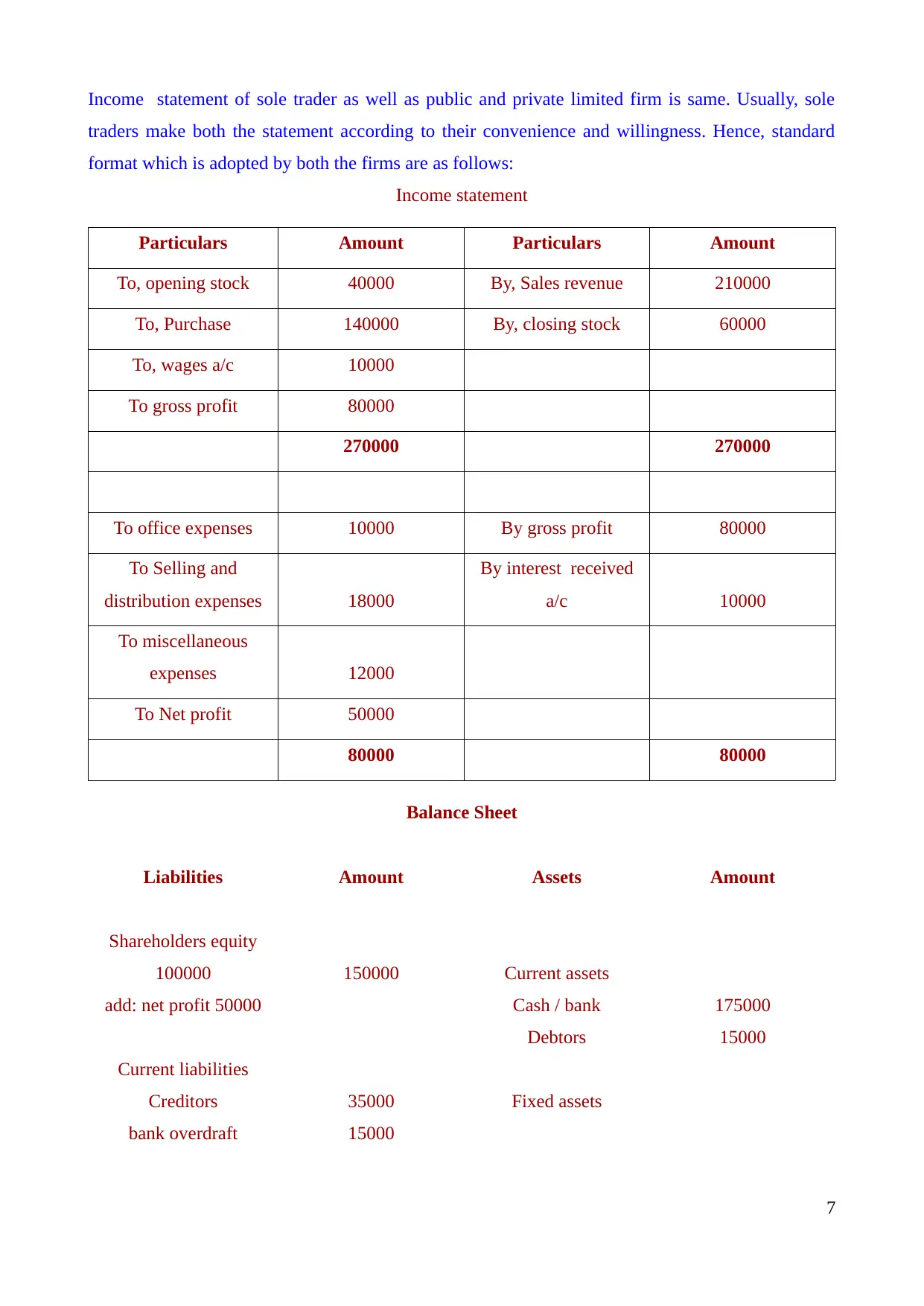
Income statement of sole trader as well as public and private limited firm is same. Usually, sole
traders make both the statement according to their convenience and willingness. Hence, standard
format which is adopted by both the firms are as follows:
Income statement
Particulars Amount Particulars Amount
To, opening stock 40000 By, Sales revenue 210000
To, Purchase 140000 By, closing stock 60000
To, wages a/c 10000
To gross profit 80000
270000 270000
To office expenses 10000 By gross profit 80000
To Selling and
distribution expenses 18000
By interest received
a/c 10000
To miscellaneous
expenses 12000
To Net profit 50000
80000 80000
Balance Sheet
Liabilities Amount Assets Amount
Shareholders equity
100000 150000 Current assets
add: net profit 50000 Cash / bank 175000
Debtors 15000
Current liabilities
Creditors 35000 Fixed assets
bank overdraft 15000
7
traders make both the statement according to their convenience and willingness. Hence, standard
format which is adopted by both the firms are as follows:
Income statement
Particulars Amount Particulars Amount
To, opening stock 40000 By, Sales revenue 210000
To, Purchase 140000 By, closing stock 60000
To, wages a/c 10000
To gross profit 80000
270000 270000
To office expenses 10000 By gross profit 80000
To Selling and
distribution expenses 18000
By interest received
a/c 10000
To miscellaneous
expenses 12000
To Net profit 50000
80000 80000
Balance Sheet
Liabilities Amount Assets Amount
Shareholders equity
100000 150000 Current assets
add: net profit 50000 Cash / bank 175000
Debtors 15000
Current liabilities
Creditors 35000 Fixed assets
bank overdraft 15000
7
Paraphrase This Document
Need a fresh take? Get an instant paraphrase of this document with our AI Paraphraser
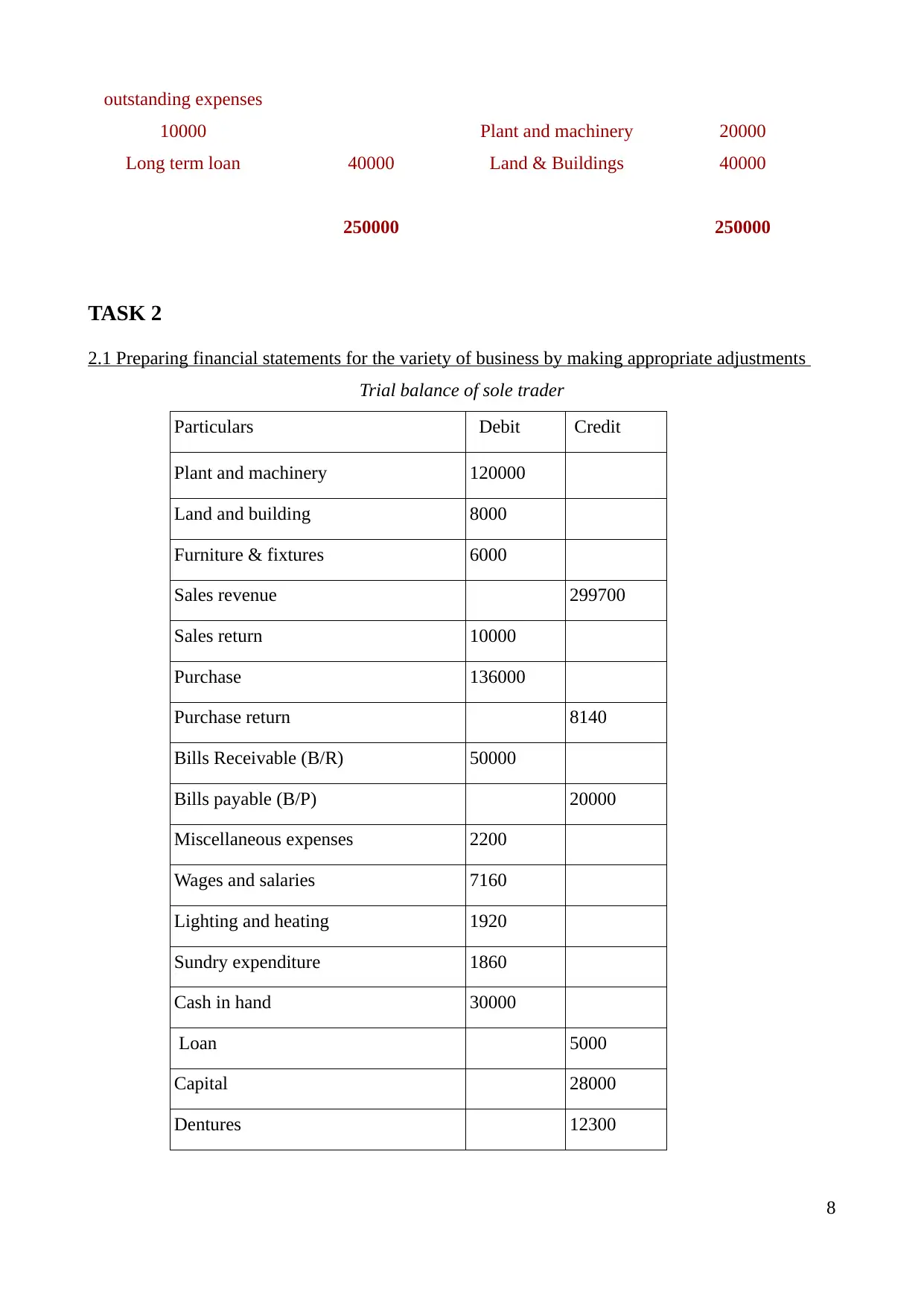
outstanding expenses
10000 Plant and machinery 20000
Long term loan 40000 Land & Buildings 40000
250000 250000
TASK 2
2.1 Preparing financial statements for the variety of business by making appropriate adjustments
Trial balance of sole trader
Particulars Debit Credit
Plant and machinery 120000
Land and building 8000
Furniture & fixtures 6000
Sales revenue 299700
Sales return 10000
Purchase 136000
Purchase return 8140
Bills Receivable (B/R) 50000
Bills payable (B/P) 20000
Miscellaneous expenses 2200
Wages and salaries 7160
Lighting and heating 1920
Sundry expenditure 1860
Cash in hand 30000
Loan 5000
Capital 28000
Dentures 12300
8
10000 Plant and machinery 20000
Long term loan 40000 Land & Buildings 40000
250000 250000
TASK 2
2.1 Preparing financial statements for the variety of business by making appropriate adjustments
Trial balance of sole trader
Particulars Debit Credit
Plant and machinery 120000
Land and building 8000
Furniture & fixtures 6000
Sales revenue 299700
Sales return 10000
Purchase 136000
Purchase return 8140
Bills Receivable (B/R) 50000
Bills payable (B/P) 20000
Miscellaneous expenses 2200
Wages and salaries 7160
Lighting and heating 1920
Sundry expenditure 1860
Cash in hand 30000
Loan 5000
Capital 28000
Dentures 12300
8
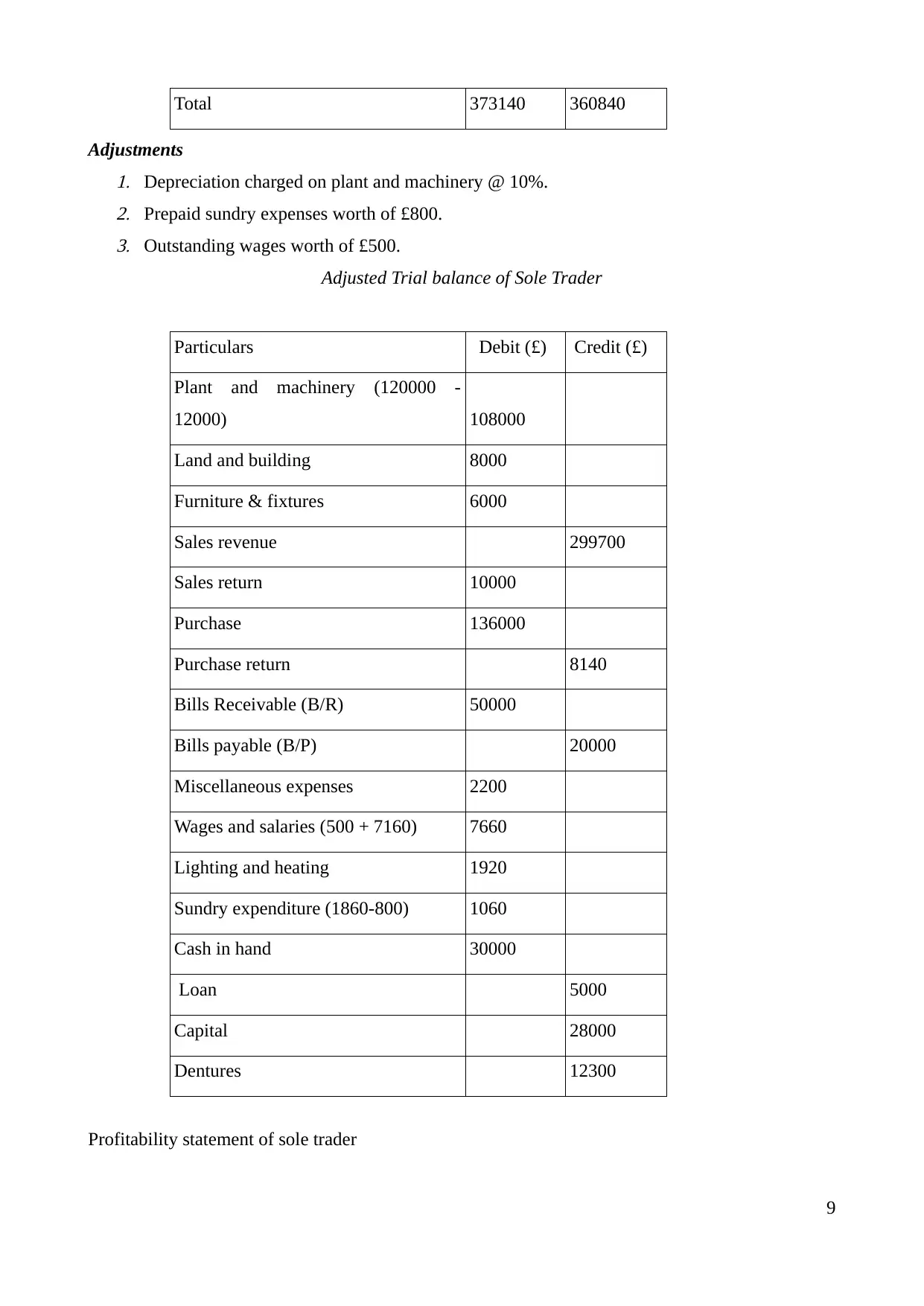
Total 373140 360840
Adjustments1. Depreciation charged on plant and machinery @ 10%.2. Prepaid sundry expenses worth of £800.3. Outstanding wages worth of £500.
Adjusted Trial balance of Sole Trader
Particulars Debit (£) Credit (£)
Plant and machinery (120000 -
12000) 108000
Land and building 8000
Furniture & fixtures 6000
Sales revenue 299700
Sales return 10000
Purchase 136000
Purchase return 8140
Bills Receivable (B/R) 50000
Bills payable (B/P) 20000
Miscellaneous expenses 2200
Wages and salaries (500 + 7160) 7660
Lighting and heating 1920
Sundry expenditure (1860-800) 1060
Cash in hand 30000
Loan 5000
Capital 28000
Dentures 12300
Profitability statement of sole trader
9
Adjustments1. Depreciation charged on plant and machinery @ 10%.2. Prepaid sundry expenses worth of £800.3. Outstanding wages worth of £500.
Adjusted Trial balance of Sole Trader
Particulars Debit (£) Credit (£)
Plant and machinery (120000 -
12000) 108000
Land and building 8000
Furniture & fixtures 6000
Sales revenue 299700
Sales return 10000
Purchase 136000
Purchase return 8140
Bills Receivable (B/R) 50000
Bills payable (B/P) 20000
Miscellaneous expenses 2200
Wages and salaries (500 + 7160) 7660
Lighting and heating 1920
Sundry expenditure (1860-800) 1060
Cash in hand 30000
Loan 5000
Capital 28000
Dentures 12300
Profitability statement of sole trader
9
⊘ This is a preview!⊘
Do you want full access?
Subscribe today to unlock all pages.

Trusted by 1+ million students worldwide
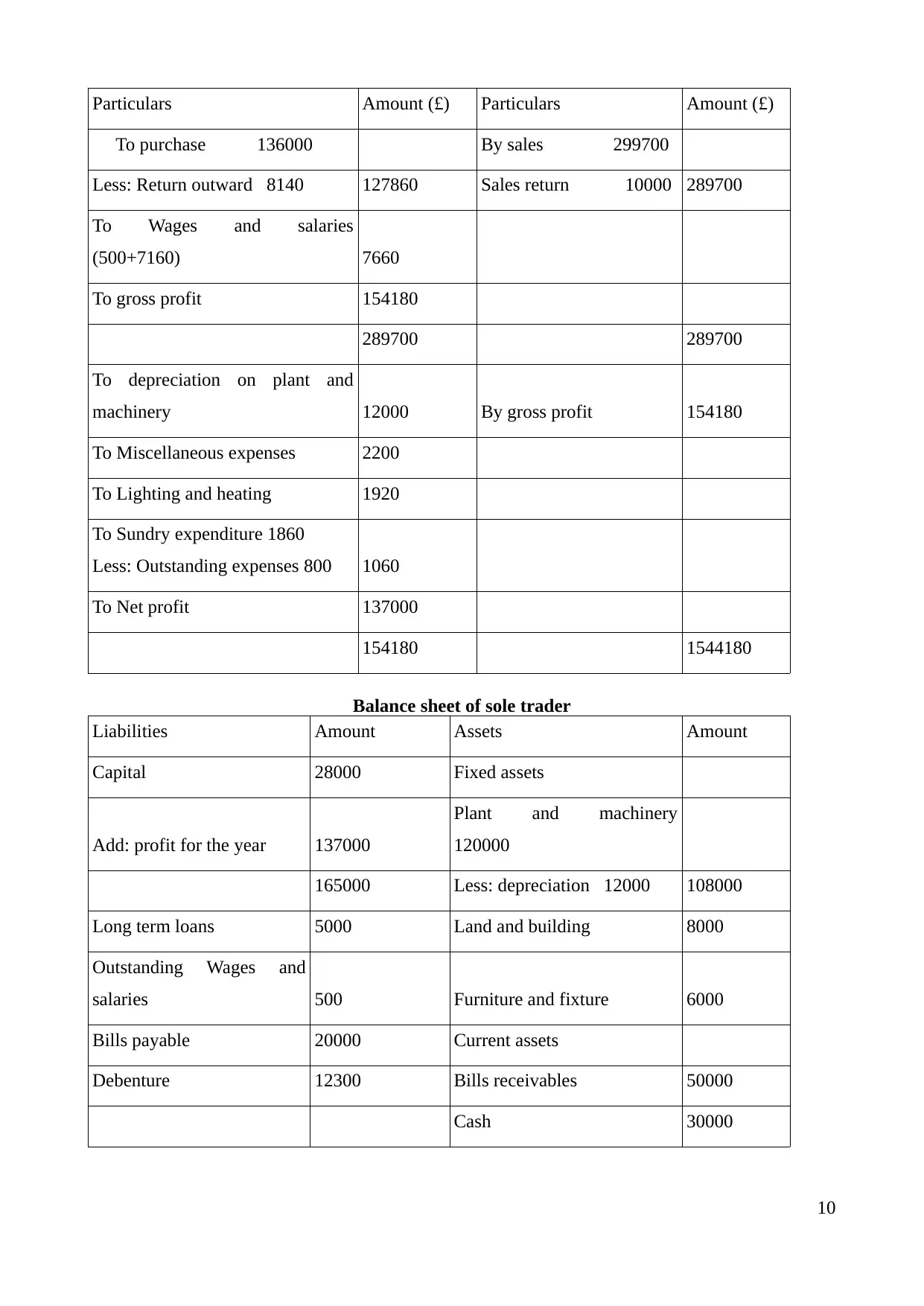
Particulars Amount (£) Particulars Amount (£)
To purchase 136000 By sales 299700
Less: Return outward 8140 127860 Sales return 10000 289700
To Wages and salaries
(500+7160) 7660
To gross profit 154180
289700 289700
To depreciation on plant and
machinery 12000 By gross profit 154180
To Miscellaneous expenses 2200
To Lighting and heating 1920
To Sundry expenditure 1860
Less: Outstanding expenses 800 1060
To Net profit 137000
154180 1544180
Balance sheet of sole trader
Liabilities Amount Assets Amount
Capital 28000 Fixed assets
Add: profit for the year 137000
Plant and machinery
120000
165000 Less: depreciation 12000 108000
Long term loans 5000 Land and building 8000
Outstanding Wages and
salaries 500 Furniture and fixture 6000
Bills payable 20000 Current assets
Debenture 12300 Bills receivables 50000
Cash 30000
10
To purchase 136000 By sales 299700
Less: Return outward 8140 127860 Sales return 10000 289700
To Wages and salaries
(500+7160) 7660
To gross profit 154180
289700 289700
To depreciation on plant and
machinery 12000 By gross profit 154180
To Miscellaneous expenses 2200
To Lighting and heating 1920
To Sundry expenditure 1860
Less: Outstanding expenses 800 1060
To Net profit 137000
154180 1544180
Balance sheet of sole trader
Liabilities Amount Assets Amount
Capital 28000 Fixed assets
Add: profit for the year 137000
Plant and machinery
120000
165000 Less: depreciation 12000 108000
Long term loans 5000 Land and building 8000
Outstanding Wages and
salaries 500 Furniture and fixture 6000
Bills payable 20000 Current assets
Debenture 12300 Bills receivables 50000
Cash 30000
10
Paraphrase This Document
Need a fresh take? Get an instant paraphrase of this document with our AI Paraphraser
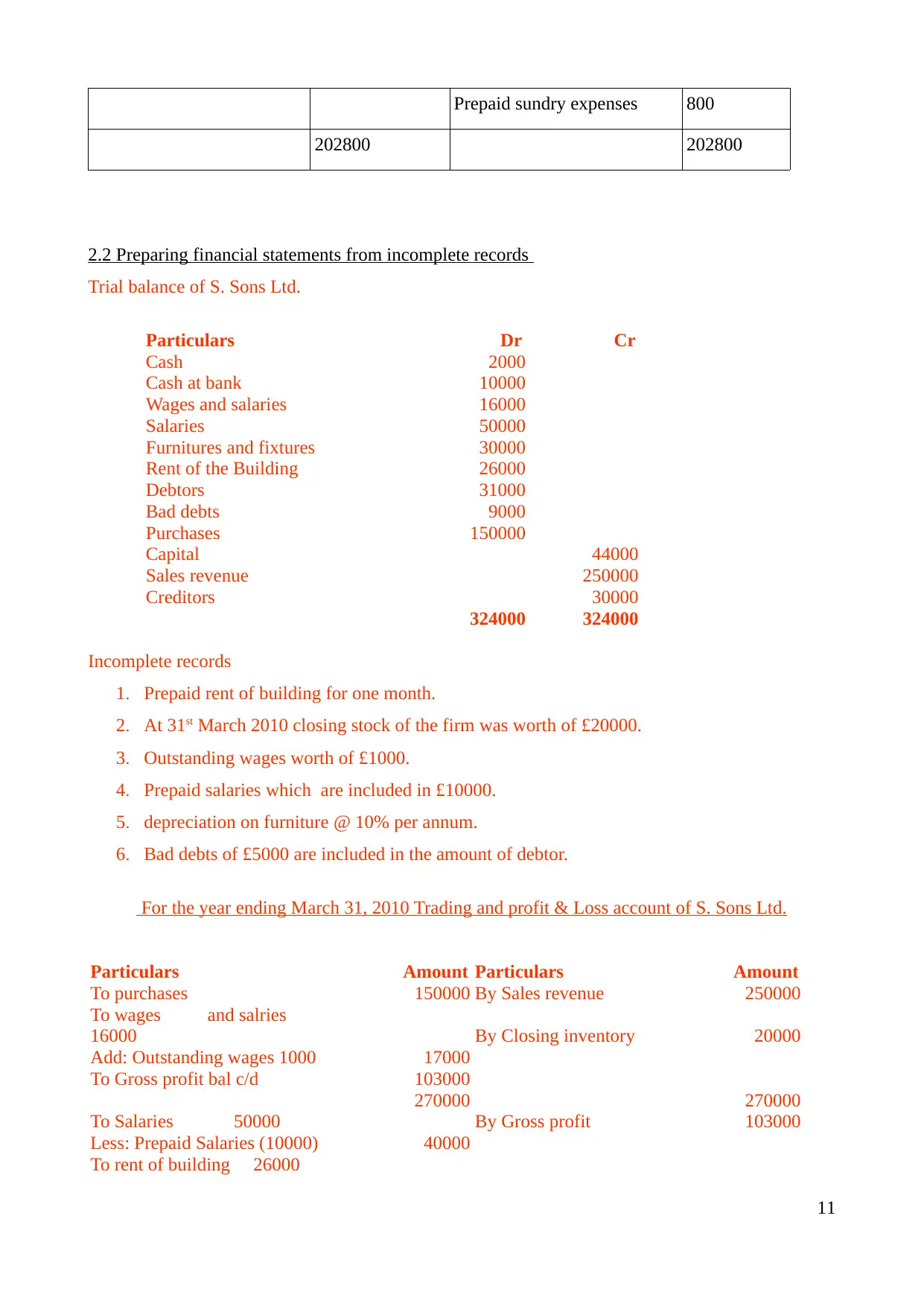
Prepaid sundry expenses 800
202800 202800
2.2 Preparing financial statements from incomplete records
Trial balance of S. Sons Ltd.
Particulars Dr Cr
Cash 2000
Cash at bank 10000
Wages and salaries 16000
Salaries 50000
Furnitures and fixtures 30000
Rent of the Building 26000
Debtors 31000
Bad debts 9000
Purchases 150000
Capital 44000
Sales revenue 250000
Creditors 30000
324000 324000
Incomplete records
1. Prepaid rent of building for one month.
2. At 31st March 2010 closing stock of the firm was worth of £20000.
3. Outstanding wages worth of £1000.
4. Prepaid salaries which are included in £10000.
5. depreciation on furniture @ 10% per annum.
6. Bad debts of £5000 are included in the amount of debtor.
For the year ending March 31, 2010 Trading and profit & Loss account of S. Sons Ltd.
Particulars Amount Particulars Amount
To purchases 150000 By Sales revenue 250000
To wages and salries
16000 By Closing inventory 20000
Add: Outstanding wages 1000 17000
To Gross profit bal c/d 103000
270000 270000
To Salaries 50000 By Gross profit 103000
Less: Prepaid Salaries (10000) 40000
To rent of building 26000
11
202800 202800
2.2 Preparing financial statements from incomplete records
Trial balance of S. Sons Ltd.
Particulars Dr Cr
Cash 2000
Cash at bank 10000
Wages and salaries 16000
Salaries 50000
Furnitures and fixtures 30000
Rent of the Building 26000
Debtors 31000
Bad debts 9000
Purchases 150000
Capital 44000
Sales revenue 250000
Creditors 30000
324000 324000
Incomplete records
1. Prepaid rent of building for one month.
2. At 31st March 2010 closing stock of the firm was worth of £20000.
3. Outstanding wages worth of £1000.
4. Prepaid salaries which are included in £10000.
5. depreciation on furniture @ 10% per annum.
6. Bad debts of £5000 are included in the amount of debtor.
For the year ending March 31, 2010 Trading and profit & Loss account of S. Sons Ltd.
Particulars Amount Particulars Amount
To purchases 150000 By Sales revenue 250000
To wages and salries
16000 By Closing inventory 20000
Add: Outstanding wages 1000 17000
To Gross profit bal c/d 103000
270000 270000
To Salaries 50000 By Gross profit 103000
Less: Prepaid Salaries (10000) 40000
To rent of building 26000
11
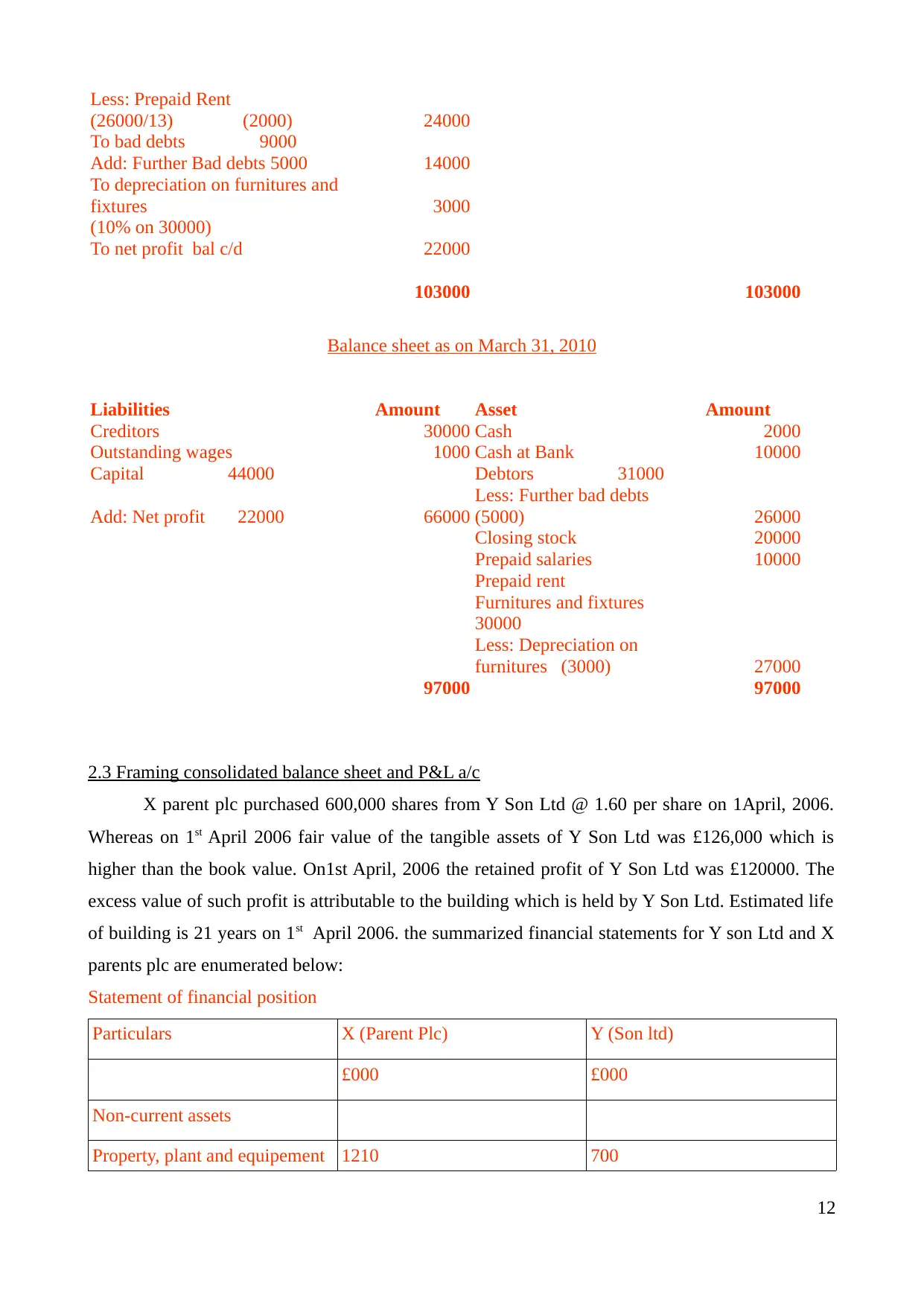
Less: Prepaid Rent
(26000/13) (2000) 24000
To bad debts 9000
Add: Further Bad debts 5000 14000
To depreciation on furnitures and
fixtures 3000
(10% on 30000)
To net profit bal c/d 22000
103000 103000
Balance sheet as on March 31, 2010
Liabilities Amount Asset Amount
Creditors 30000 Cash 2000
Outstanding wages 1000 Cash at Bank 10000
Capital 44000 Debtors 31000
Add: Net profit 22000 66000
Less: Further bad debts
(5000) 26000
Closing stock 20000
Prepaid salaries 10000
Prepaid rent
Furnitures and fixtures
30000
Less: Depreciation on
furnitures (3000) 27000
97000 97000
2.3 Framing consolidated balance sheet and P&L a/c
X parent plc purchased 600,000 shares from Y Son Ltd @ 1.60 per share on 1April, 2006.
Whereas on 1st April 2006 fair value of the tangible assets of Y Son Ltd was £126,000 which is
higher than the book value. On1st April, 2006 the retained profit of Y Son Ltd was £120000. The
excess value of such profit is attributable to the building which is held by Y Son Ltd. Estimated life
of building is 21 years on 1st April 2006. the summarized financial statements for Y son Ltd and X
parents plc are enumerated below:
Statement of financial position
Particulars X (Parent Plc) Y (Son ltd)
£000 £000
Non-current assets
Property, plant and equipement 1210 700
12
(26000/13) (2000) 24000
To bad debts 9000
Add: Further Bad debts 5000 14000
To depreciation on furnitures and
fixtures 3000
(10% on 30000)
To net profit bal c/d 22000
103000 103000
Balance sheet as on March 31, 2010
Liabilities Amount Asset Amount
Creditors 30000 Cash 2000
Outstanding wages 1000 Cash at Bank 10000
Capital 44000 Debtors 31000
Add: Net profit 22000 66000
Less: Further bad debts
(5000) 26000
Closing stock 20000
Prepaid salaries 10000
Prepaid rent
Furnitures and fixtures
30000
Less: Depreciation on
furnitures (3000) 27000
97000 97000
2.3 Framing consolidated balance sheet and P&L a/c
X parent plc purchased 600,000 shares from Y Son Ltd @ 1.60 per share on 1April, 2006.
Whereas on 1st April 2006 fair value of the tangible assets of Y Son Ltd was £126,000 which is
higher than the book value. On1st April, 2006 the retained profit of Y Son Ltd was £120000. The
excess value of such profit is attributable to the building which is held by Y Son Ltd. Estimated life
of building is 21 years on 1st April 2006. the summarized financial statements for Y son Ltd and X
parents plc are enumerated below:
Statement of financial position
Particulars X (Parent Plc) Y (Son ltd)
£000 £000
Non-current assets
Property, plant and equipement 1210 700
12
⊘ This is a preview!⊘
Do you want full access?
Subscribe today to unlock all pages.

Trusted by 1+ million students worldwide
1 out of 18
Related Documents
Your All-in-One AI-Powered Toolkit for Academic Success.
+13062052269
info@desklib.com
Available 24*7 on WhatsApp / Email
![[object Object]](/_next/static/media/star-bottom.7253800d.svg)
Unlock your academic potential
Copyright © 2020–2025 A2Z Services. All Rights Reserved. Developed and managed by ZUCOL.





